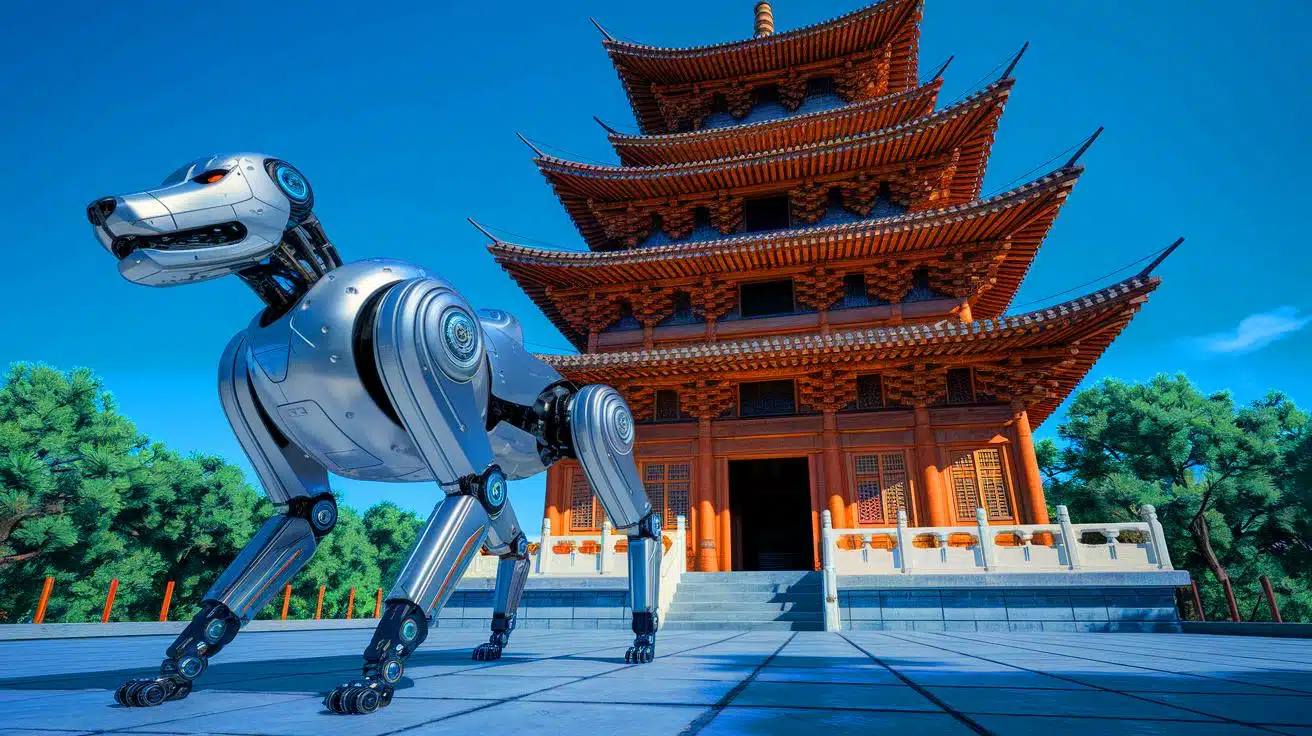In an extraordinary blend of ancient culture and modern technology, China has deployed a six legged AI robotic dog to patrol and safeguard the world famous Yingxian Wooden Pagoda. This remarkable initiative not only showcases the country’s growing expertise in robotics and artificial intelligence but also highlights a renewed global commitment to preserving cultural heritage through cutting edge solutions.
The ancient wooden temple, located in Shanxi Province, has stood for nearly a thousand years. But time, weather, and human interference have posed constant threats to its structural integrity. Now, technology offers a new hope in the form of the Daystar Bot GS an AI robotic dog equipped with military grade awareness and high tech monitoring capabilities.
The Yingxian Wooden Pagoda: A Cultural Treasure at Risk
The Yingxian Wooden Pagoda, also known as the Sakyamuni Pagoda, is the oldest and tallest wooden pagoda in the world. Constructed in 1056 during the Liao Dynasty, this architectural wonder rises nearly 67 meters (220 feet) high, entirely made of timber without a single iron nail. Its intricate structure and rich carvings are a testament to ancient Chinese craftsmanship.
However! preserving such an ancient wooden structure is a daunting task. The pagoda faces constant challenges from earthquakes, weathering, and human activity. Traditional surveillance and maintenance methods, while valuable, often fall short in providing real time insights or rapid response to emerging risks.
Daystar Bot GS: The AI Robotic Dog on a Cultural Mission
Enter the Daystar Bot GS a state of the f,art AI robotic dog developed by Chinese robotics firms with roots in both civilian and military technology sectors. Unlike conventional four legged robots, this six legged design offers superior stability, mobility, and adaptability, particularly on uneven terrain like the temple grounds.
Equipped with AI powered navigation, real time data collection, 3D mapping, and environmental sensors, the robot continuously monitors the temple’s surroundings. Its capabilities include:
✅ High resolution visual scanning
✅ Structural integrity assessment
✅ Intruder detection with military grade awareness
✅ Early warning for potential fire or environmental hazards
✅ Remote controlled or autonomous operation
AI in Heritage Protection
China isn’t alone in embracing robotics for cultural preservation. In Italy, similar robots patrol Pompeii, detecting structural weaknesses before they escalate. Japan uses AI powered drones to monitor ancient temples and shrines threatened by earthquakes. But what sets the AI robotic dog apart is its six legged design, providing unmatched agility and coverage for delicate, ancient environments.

A Game Changer for Cultural Heritage
Professor Zhang Wei, a cultural heritage preservation specialist at Tsinghua University, calls this deployment “a milestone in the fusion of artificial intelligence and heritage conservation.” He explains:
“The Yingxian Wooden Pagoda has stood for nearly a millennium, but its greatest challenges lie ahead climate change, natural disasters, and human negligence. By integrating the AI robotic dog, we’re not just reacting to damage, we’re preventing it.”
Similarly, Dr. Emily Carter, a robotics researcher at MIT, applauds the initiative:
“China’s use of the AI robotic dog demonstrates how AI and robotics are transcending traditional industrial applications and entering the domain of cultural preservation. This proactive approach could redefine how humanity protects its irreplaceable historical treasures.”
Military Grade Awareness: Is It Overkill or Necessity?
Some skeptics have questioned whether deploying a military grade AI robotic dog for temple protection is excessive. However, recent events suggest otherwise. In 2022, unauthorized drone activity near the Forbidden City raised alarms over potential security breaches at historical sites. The ability of the Daystar Bot GS to detect and respond to such threats adds an essential layer of security.
Moreover, heritage sites are increasingly vulnerable to theft, vandalism, and accidental damage from tourism. With its advanced AI driven surveillance, the AI robotic dog offers not just protection but peace of mind.
Witnessing the Robotic Dog in Action
Visitors to the Yingxian Wooden Pagoda have expressed awe and curiosity upon seeing the AI robotic dog at work. Li Ming, a local tour guide, shares his perspective:
“At first, some were surprised, even amused, to see this robotic creature patrolling the grounds. But once they understood its role ensuring the safety of our ancient temple admiration replaced skepticism. It’s a symbol of how we honor the past while embracing the future.”
For many locals, the AI robotic dog represents more than technology it symbolizes respect for heritage and a promise to future generations.
The Future of AI in Cultural Preservation
The successful deployment of the Daystar Bot GS could signal a broader global trend. As AI and robotics evolve, their role in cultural heritage protection will likely expand in several ways:
Predictive Maintenance: AI can analyze structural data to predict and prevent damage before it occurs.
Environmental Monitoring: Robots can track humidity, temperature, and other environmental factors critical to preservation.
Remote Access: AI driven robots can inspect hard to reach areas, reducing human risk.
Education & Engagement: Interactive AI tools can educate the public about the importance of heritage conservation.
The AI robotic dog isn’t just a short-term solution it represents a shift toward intelligent, proactive protection of human history.
A Bold Step into the Future
The deployment of a six legged AI robotic dog to patrol the Yingxian Wooden Pagoda is a bold, innovative step that bridges the gap between ancient tradition and modern technology. By harnessing AI’s potential, China is setting a precedent for how the world can and must safeguard its irreplaceable cultural heritage.
While some may view this as a technological novelty, it reflects a profound respect for the past and a visionary approach to the future. As global threats to heritage sites grow, the need for intelligent, adaptable protection methods like the AI robotic dog will only become more urgent.
Ultimately, this isn’t just about robotics. It’s about responsibility to history, to culture, and to the generations yet to come.


1 thought on “China’s AI Robotic Dog Guards Ancient Wooden Temple With Military Grade Precision”